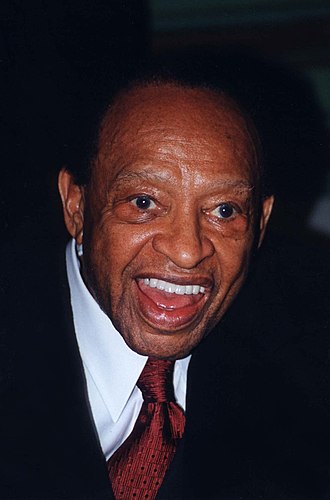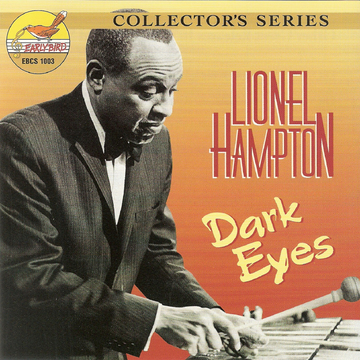
Hampton, Lionel
Lionel Hampton was born in 1908 in Louisville, Kentucky, and was raised by his mother. Shortly after he was born, he and his mother moved to her hometown of Birmingham, Alabama. He spent his early childhood in Kenosha, Wisconsin, before he and his family moved to Chicago, Illinois, in 1916. As a youth, Hampton was a member of the Bud Billiken Club, an alternative to the Boy Scouts of America, which was off-limits because of racial segregation. During the 1920s, while still a teenager, Hampton took xylophone lessons from Jimmy Bertrand and began to play drums. Hampton was raised Catholic, and started out playing fife and drum at the Holy Rosary Academy near Chicago]
Lionel Hampton began his career playing drums for the Chicago Defender Newsboys’ Band (led by Major N. Clark Smith) while still a teenager in Chicago. He moved to California in 1927 or 1928, playing drums for the Dixieland Blues-Blowers. While he lived in Chicago, Hampton saw Louis Armstrong at the Vendome, remembering that the entire audience went crazy after his first solo. He made his recording debut with The Quality Serenaders led by Paul Howard, then left for Culver City and drummed for the Les Hite band at Sebastian’s Cotton Club. One of his trademarks as a drummer was his ability to do stunts with multiple pairs of sticks such as twirling and juggling without missing a beat. During this period, he began practicing on the vibraphone. In 1930 Louis Armstrong came to California and hired the Les Hite band for performances and recordings. Armstrong was impressed with Hampton’s playing after Hampton reproduced Armstrong’s solo on the vibraphone and asked him to play behind him like that during vocal choruses. So began his career as a vibraphonist, popularizing the use of the instrument in the process. Invented ten years earlier, the vibraphone is essentially a xylophone with metal bars, a sustain pedal, and resonators equipped with electric-powered fans that add tremolo.
While working with the Les Hite band, Hampton also occasionally did some performing with Nat Shilkret and his orchestra. During the early 1930s, he studied music at the University of Southern California. In 1934 he led his own orchestra, and then appeared in the Bing Crosby film Pennies From Heaven (1936) alongside Louis Armstrong (wearing a mask in a scene while playing drums).
In November 1936, the Benny Goodman Orchestra came to Los Angeles to play the Palomar Ballroom. When John Hammond brought Goodman to see Hampton perform, Goodman invited him to join his trio, which soon became the Benny Goodman Quartet with Teddy Wilson and Gene Krupa completing the lineup. The Trio and Quartet were among the first racially integrated jazz groups to perform before audiences, and were a leading small-group of the day.
Hampton’s orchestra developed a high-profile during the 1940s and early 1950s. His third recording with them in 1942 produced the version of “Flying Home“, featuring a solo by Illinois Jacquet that anticipated rhythm & blues. Although Hampton first recorded “Flying Home” under his own name with a small group in 1940 for Victor, the best known version is the big band version recorded for Decca on May 26, 1942, in a new arrangement by Hampton’s pianist Milt Buckner. The 78 RPM disc became successful enough for Hampton to record “Flyin’ Home #2” in 1944, this time a feature for Arnett Cobb. The song went on to become the theme song for all three men. Guitarist Billy Mackel first joined Hampton in 1944, and would perform and record with him almost continuously through to the late 1970s.[17] In 1947, Hamp performed “Stardust” at a “Just Jazz” concert for producer Gene Norman, also featuring Charlie Shavers and Slam Stewart; the recording was issued by Decca. Later, Norman’s GNP Crescendo label issued the remaining tracks from the concert.
Hampton was a featured artist at numerous Cavalcade of Jazz concerts held at Wrigley Field in Los Angeles and produced by Leon Hefflin Sr. His first performance was at the second Cavalcade of Jazz concert held on October 12, 1946 and also featured Jack McVea, Slim Gaillard, T-Bone Walker, the Honeydrippers and Louis Armstrong. The fifth Cavalcade of Jazz concert was held in two locations, Wrigley Field in Los Angeles and Lane Field in San Diego, July 10, 1949 and September 3, 1949 respectively. Betty Carter, Jimmy Witherspoon, Buddy Banks, Smiley Turner and Big Jay McNeely also played with Hampton. It was at the sixth Cavalcade of Jazz, June 25, 1950 that precipitated the closest thing to a riot in the show’s eventful history. Lionel and his band paraded around the ball park’s infield playing ‘Flying High’. The huge crowd, around 14,000 went berserk, tossed cushions, coats, hats, programs, and just about anything else they could lay hands on and swarmed on the field.
From the mid-1940s until the early 1950s, Hampton led a lively rhythm & blues band whose Decca Records recordings included numerous young performers who later had significant careers. They included bassist Charles Mingus, saxophonist Johnny Griffin, guitarist Wes Montgomery, and vocalist Dinah Washington. Other noteworthy band members were trumpeters Dizzy Gillespie, Cat Anderson, Kenny Dorham, and Snooky Young; trombonist Jimmy Cleveland, and saxophonists Jerome Richardson and Curtis Lowe.
The Hampton orchestra that toured Europe in 1953 included Clifford Brown, Gigi Gryce, Anthony Ortega, Monk Montgomery, George Wallington, Art Farmer, Quincy Jones, and singer Annie Ross. Hampton continued to record with small groups and jam sessions during the 1940s and 1950s, with Oscar Peterson, Buddy DeFranco, and others. In 1955, while in California working on The Benny Goodman Story he recorded with Stan Getz and made two albums with Art Tatum for Norman Granz as well as with his own big band.
Hampton performed with Louis Armstrong and Italian singer Lara Saint Paul at the 1968 Sanremo Music Festival in Italy. The performance created a sensation with Italian audiences, as it broke into a real jazz session. That same year, Hampton received a Papal Medal from Pope Paul VI.
During the 1960s, Hampton’s groups were in decline; he was still performing what had succeeded for him earlier in his career. He did not fare much better in the 1970s, though he recorded actively for his Who’s Who in Jazz record label, which he founded in 1977/1978. Beginning in February 1984, Hampton and his band played at the University of Idaho‘s annual jazz festival, which was renamed the Lionel Hampton Jazz Festival the following year. In 1987 the UI’s school of music was renamed for Hampton, the first university music school named for a jazz musician.
During much of the 1980s, some notable sidemen in Hampton’s orchestra included: Thomas Chapin, Paul Jeffrey, Frankie Dunlop, Arvell Shaw, John Colianni, Oliver Jackson and George Duvivier. Hampton remained active until a stroke in Paris in 1991 led to a collapse on stage. That incident, combined with years of chronic arthritis, forced him to cut back drastically on performances. However, he did play at the Smithsonian National Museum of American History in 2001 shortly before his death.
Hampton died from congestive heart failure at Mount Sinai Hospital, New York City, on August 31, 2002. He was interred at the Woodlawn Cemetery, Bronx, New York. His funeral was held on September 7, 2002, and featured a performance by Wynton Marsalis and David Ostwald’s Gully Low Jazz Band at Riverside Church in Manhattan; the procession began at The Cotton Club in Harlem.
- 2021 – Grammy Lifetime Achievement Award (posthumous)
- 2001 – Harlem Jazz and Music Festival’s Legend Award
- 1996 – International Jazz Hall of Fame Induction and Award (performed “Flying Home” with Illinois Jacquet and the Count Basie Orchestra)
- 1996 – National Medal of Arts presented by President Bill Clinton
- 1995 – Honorary Commissioner of Civil Rights by George Pataki
- 1995 – Honorary Doctorate from the New England Conservatory of Music
- 1993 – Honorary Doctorate from the University of Maryland Eastern Shore
- 1992 – Inducted into the Alabama Jazz Hall of Fame
- 1992 – “Contributions To The Cultural Life of the Nation” award from John F. Kennedy Center for the Performing Arts
- 1988 – The National Endowment for the Arts Jazz Masters Fellowship
- 1988 – The National Association of Jazz Educators Hall of Fame Award
- 1987 – Honorary Doctorate of Humanities from the University of Idaho – UI’s School of Music renamed “Lionel Hampton School of Music”
- 1987 – The Roy Wilkins Memorial Award from the NAACP
- 1986 – The “One of a Kind” Award from Broadcast Music, Inc.
- 1984 – Jazz Hall of Fame Award from the Institute of Jazz Studies
- 1984 – Honorary Doctorate of Music from USC
- 1983 – The International Film and Television Festival of New York City Award
- 1983 – Honorary Doctorate of Humane Letters from the State University of New York
- 1982 – Hollywood Walk of Fame Star
- 1981 – Honorary Doctorate of Humanities from Glassboro State College
- 1979 – Honorary Doctorate of Music from Howard University
- 1978 – Bronze Medallion from New York City
- 1976 – Honorary Doctorate of Humanities from Daniel Hale Williams University
- 1975 – Honorary Doctorate of Music from Xavier University of Louisiana
- 1974 – Honorary Doctorate of Fine Arts from Pepperdine University
- 1968 – Papal Medal from Pope Paul VI
- 1966 – Handel Medallion
- 1957 – American Goodwill Ambassador by President Dwight D. Eisenhower
- 1954 – Israel’s Statehood Award
